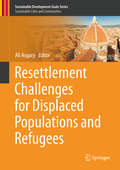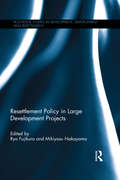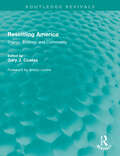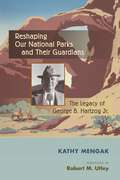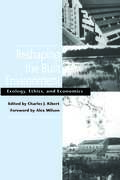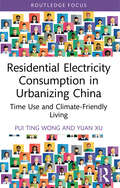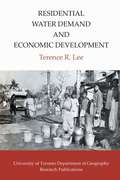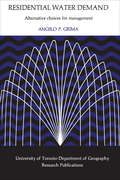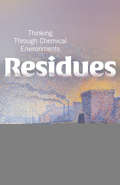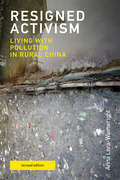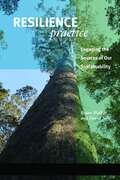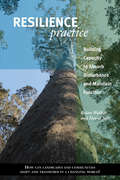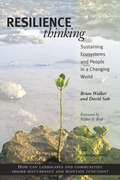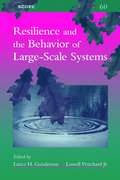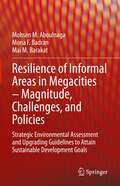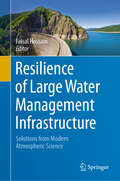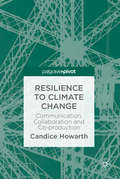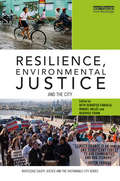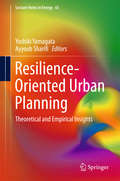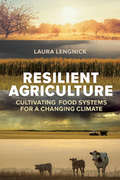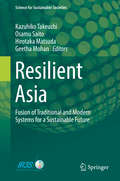- Table View
- List View
Resettlement Challenges for Displaced Populations and Refugees (Sustainable Development Goals Series)
by Ali AsgaryThe main focus of this book is to help better understand the multidimensionality and complexity of population displacement and the role that reconstruction and recovery knowledge and practice play in this regard. According to the UN Refugee Agency (UNHCR), the total number of people forcibly displaced due to wars and conflicts, disasters, and climate change worldwide, exceeded 66 million in 2016. Many of these displaced populations may never be able to go back and rebuild their houses, communities, and businesses.This text brings together recovery and reconstruction professionals, researchers, and policy makers to examine how displaced populations can rebuild their lives in new locations and recover from disasters that have impacted their livelihoods, and communities. This book provides readers with an understanding of how disaster recovery and reconstruction knowledge and practice can contribute to the recovery and reconstruction of displaced and refugee populations. This book will appeal to students, researchers, and professionals working in the field.
Resettlement Policy in Large Development Projects (Routledge Studies in Development, Displacement and Resettlement)
by Ryo Fujikura Mikiyasu NakayamaHydropower generation by construction of large dams attracts considerable attention as a feasible renewable energy source to meet the power demand in Asian cities. However, large development projects cause involuntary resettlement. Of the world’s forty to eighty million resettlers, many resettlers have been unable to rebuild their livelihood after relocation and have become impoverished. This book uniquely explores the long-term impacts of displacement and resettlement. It shows that long-term post-project evaluation is necessary to assess the rehabilitation and livelihood reconstruction of resettlers after relocation. It focuses on large dam projects in a number of Asian countries, including Indonesia, Japan, Laos, Turkey, Sri Lanka and Vietnam, which are often ignored in Displacement studies in favour of China or India. Drawing on a wealth of empirical data over ten years, it presents crucial factors for successful resettlement by analysing lessons learned. The range of countries allow for a diverse and complex set of factors and outcomes to be analysed. Many of the factors for successful resettlement recur despite the cases being different in implementation period and location. The book presents highly original findings gathered by local researchers in the field directly talking to resettlers who were relocated more than a decade ago. This original book is a unique resource for researchers and postgraduate students of development studies, environment, geography, sociology and anthropology. It also makes policy recommendations for future resettlement programs that are of great value to development policy makers, planners, water resources engineers and civil society protest groups.
Resettling America: Energy, Ecology and Community (Routledge Revivals)
by Gary J. CoatesEvery movement has its bellweathers, the ideas that lead the way and rally its adherents towards a set of shared values and visions. Resettling America was one such beacon – a publication for its time and ahead of its time. Those of us doing the work of sustainability and the transformation of communities feel grateful for Gary’s early and prescient contribution that has shaped the thinking of so many around the US and beyond. Essential reading for all green warriors! Jason F. McLennan, Chief Sustainability Officer – Perkins & Will. Founder, Living Building Challenge. Originally published in 1981 and now reissued with a new Preface by Gary J. Coates, Resettling America was one of the first comprehensive, transdisciplinary books on the crisis of sustainability and the implications of that crisis for the re-design of buildings, towns, cities and regions. Through essays by Coates, which provide a theory of ecological design, and case studies written by leading authors and activists of the time, the book presents a strategic vision of how it would be possible to create a sustainable and livable society through a process of cooperative community development rooted in a radical re-visioning of nature, self and society. By providing a strategic vision, as well offering practical means for creating a sustainable society worth sustaining, Resettling America remains more relevant and inspiring than ever to those who face the ecology of crises that now surround us in the 21st Century.
Reshaping Toronto's Waterfront
by Jennefer Laidley Gene DesforLarge-scale development is once again putting Toronto's waterfront at the leading edge of change. As in other cities around the world, policymakers, planners, and developers are envisioning the waterfront as a space of promise and a prime location for massive investments. Currently, the waterfront is being marketed as a crucial territorial wedge for economic ascendancy in globally competitive urban areas.Reshaping Toronto's Waterfront analyses how and why 'problem spaces' on the waterfront have become 'opportunity spaces' during the past hundred and fifty years. Contributors with diverse areas of expertise illuminate processes of development and provide fresh analyses of the intermingling of nature and society as they appear in both physical forms and institutional arrangements, which define and produce change. Reshaping Toronto's Waterfront is a fundamental resource for understanding the waterfront as a dynamic space that is neither fully tamed nor wholly uncontrolled.
Reshaping Environments: An Interdisciplinary Approach to Sustainability in a Complex World
by Helena BenderReshaping Environments: An Interdisciplinary Approach to Sustainability in a Complex World draws together a team of specialist authors from disciplines including urban planning, social sciences, engineering and environmental science to examine the diverse influences humans have upon the natural environment. This interdisciplinary approach presents multifaceted responses for complex environmental issues. The book explores current environmental science theories to provide a solid foundation of theoretical knowledge. Drawing on a range of case studies, it develops core analytical skills for application to real-world environmental issues. Reshaping Environments gives environmental science students the tools and insight to comprehend the range of influences society imposes on the natural environment. It is essential reading for those interested in creating a mutually beneficial future for human society and the natural environment.
Reshaping Our National Parks and Their Guardians: The Legacy of George B. Hartzog Jr.
by Kathy MengakThis biography of the seventh director of the National Park Service brings to life one of the most colorful, powerful, and politically astute people to hold this position. George B. Hartzog Jr. served during an exciting and volatile era in American history. Appointed in 1964 by Secretary of the Interior Stewart Udall, he benefited from a rare combination of circumstances that favored his vision, which was congenial with both President Lyndon Johnson&’s &“Great Society&” and Udall&’s robust environmentalism.Hartzog led the largest expansion of the National Park System in history and developed social programs that gave the Service new complexion. During his nine-year tenure, the system grew by seventy-two units totaling 2.7 million acres including not just national parks, but historical and archaeological monuments and sites, recreation areas, seashores, riverways, memorials, and cultural units celebrating minority experiences in America. In addition, Hartzog sought to make national parks relevant and responsive to the nation&’s changing needs.
Reshaping the Built Environment: Ecology, Ethics, and Economics
by Alex Wilson Charles J. KibertBecause of the profound effects of the built environment on the availability of natural resources for future generations, those involved with designing, creating, operating, renovating, and demolishing human structures have a vital role to play in working to put society on a path toward sustainability.This volume presents the thinking of leading academics and professionals in planning, civil engineering, economics, ecology, architecture, landscape architecture, construction, and related fields who are seeking to discover ways of creating a more sustainable built environment. Contributors address the broad range of issues involved, offering both insights and practical examples. In the book: Stephen Kellert describes the scope of the looming ecological crisis Herman Daly explains the unsustainability of the world's economic system and the dangers inherent in the current movement toward globalization John Todd describes the evolution of wastewater processing systems inspired by natural systems John Tillman Lyle discusses the importance of landscape in the creation of the human environment Randall Arendt argues for a fundamental shift in land development patterns that would not only provide for more green space in new developments, but would also increase the profitability of developers and the quality of life for new home owners Thomas E. Graedel proposes the application of lessons learned from the emerging science of industrial ecology to the creation of "green" building. While the transition to sustainability will not be easy, natural systems provide abundant models of architecture, engineering, production, and waste conversion that can be used in rethinking the human habitat and its interconnections. This volume provides insights that can light the way to a new era in which a reshaped built environment will not only provide improved human living conditions, but will also protect and respect the earth's essential natural life-support systems and resources.
Residential Electricity Consumption in Urbanizing China: Time Use and Climate-Friendly Living (Routledge Focus on Energy Studies)
by Yuan Xu Pui Ting WongThis book forges a link between residential CO2 emissions and time use, focussing on China as a key case study. To provide a better understanding of the energy implications of the lifestyle differences between urban and rural China, Pui Ting Wong and Yuan Xu utilise time-use methodology as an alternative way to explore the links between individual lifestyle and residential electricity consumption. They begin by examining how Chinese citizens divide their time between daily activities, highlighting patterns around indicators including age, gender, education, and economic status. They go on to quantify CO2 intensities of these time-use activities. Through this linkage, this book presents an alternative strategy for climate-friendly living, highlighting the ways in which urban planning can be deployed to help individuals adapt their time-use patterns for CO2 mitigation. Providing a novel contribution to the growing literature on residential electricity consumption, Residential Electricity Consumption in Urbanizing China will be of great interest to scholars of climate policy, energy studies, time use, and urban planning.
Residential Water Demand and Economic Development (The Royal Society of Canada Special Publications #2)
by Terence LeeIn the last twenty years the problem of urban public water supples has become increasingly serious. Disparities between the effective supply of, and demand for, water has grown rapidly and now constitute a danger to public health. This study deals with the place of urban public water supplies in economic development and with the demand for such elements of the social infrastructure during the process of economic and social growth. Based on an examination of the existing water-use systems in two urban areas in India, this study provides valuable information in a field that is of growing concern to all the developing countries of the world.
Residential Water Demand: Alternative Choices for Management
by Angelo P. GrimaThis detailed study of the use of water at different price levels by residential consumers in the Toronto-centred region from Hamilton to Oshawa challenges the basis of our present urban water supply policy. Adoption of the recommendations presented would mean higher prices to householders, but a considerable saving of hundreds of millions of tax dollars over the next three decades. The present policy uses a 'requirement approach' in which future water needs are calculated by extrapolation of past trends and an assumption that demand is inelastic. This leads to excessive levels of water use and over-investment in water supply, sewage collection, and treatment systems. The resultant misallocation of resources can be corrected by adoption of a demand/management approach in which investment policy is guided by consumer demand and alternative pricing arrangements are used as a management tool. Dr. Grima examines several alternative choices for management, such as metering, increasing marginal prices, sewerage charges, seasonal charges, and an increasing price block schedule, and describes the results of each. Water managers in Canada are strongly challenged to begin a fundamental rethinking of their basic policies. (Department of Geography Research Publication 7)
Residues: Thinking Through Chemical Environments (Nature, Society, and Culture)
by Nathalie Jas Soraya Boudia Scott Frickel Carsten Reinhardt Angela N. Creager Emmanuel Henry Jody A. RobertsResidues offers readers a new approach for conceptualizing the environmental impacts of chemicals production, consumption, disposal, and regulation. Environmental protection regimes tend to be highly segmented according to place, media, substance, and effect; academic scholarship often reflects this same segmented approach. Yet, in chemical substances we encounter phenomena that are at once voluminous and miniscule, singular and ubiquitous, regulated yet unruly. Inspired by recent studies of materiality and infrastructures, we introduce “residual materialism” as a framework for attending to the socio-material properties of chemicals and their world-making powers. Tracking residues through time, space, and understanding helps us see how the past has been built into our present chemical environments and future-oriented regulatory systems, why contaminants seem to always evade control, and why the Anthropocene is as inextricably harnessed to the synthesis of carbon into new molecules as it is driven by carbon’s combustion.
Resigned Activism, revised edition: Living with Pollution in Rural China (Urban and Industrial Environments)
by Anna Lora-WainwrightAn examination of the daily grind of living with pollution in rural China and of the varying forms of activism that develop in response.Residents of rapidly industrializing rural areas in China live with pollution every day. Villagers drink obviously tainted water and breathe visibly dirty air, afflicted by a variety of ailments—from arthritis to nosebleeds—that they ascribe to the effects of industrial pollution. In Resigned Activism, Anna Lora-Wainwright explores the daily grind of living with pollution in rural China and the varying forms of activism that develop in response. This revised edition offers expanded acknowledgment of the contributions of Lora-Wainwright&’s collaborators in China.Lora-Wainwright finds that claims of health or environmental damage are politically sensitive, and that efforts to seek redress are frustrated by limited access to scientific evidence, growing socioeconomic inequalities, and complex local realities. Villagers, feeling powerless, often come to accept pollution as part of the environment; their activism is tempered by their resignation. Drawing on fieldwork done with teams of collaborators, Lora-Wainwright offers three case studies of &“resigned activism&” in rural China, examining the experiences of villagers who live with the effects of phosphorous mining and fertilizer production, lead and zinc mining, and electronic waste processing. The book also includes extended summaries of the in-depth research carried out by Ajiang Chen and his team in some of China&’s &“cancer villages,&” village-sized clusters of high cancer incidence. These cases make clear the staggering human costs of development and the deeply uneven distribution of costs and benefits that underlie China&’s economic power.
Resilience Practice: Building Capacity To Absorb Disturbance And Maintain Function
by Brian Walker & David SaltIn 2006, Resilience Thinking addressed an essential question: As the natural systems that sustain us are subjected to shock after shock, how much can they take and still deliver the services we need from them? This idea caught the attention of both the scientific community and the general public. In Resilience Practice, authors Brian Walker and David Salt take the notion of resilience one step further, applying resilience thinking to real-world situations and exploring how systems can be managed to promote and sustain resilience. The book begins with an overview and introduction to resilience thinking and then takes the reader through the process of describing systems, assessing their resilience, and intervening as appropriate. Following each chapter is a case study of a different type of social-ecological system and how resilience makes a difference to that system in practice. The final chapters explore resilience in other arenas, including on a global scale. Resilience Practice will help people with an interest in the “coping capacity” of systems—from farms and catchments to regions and nations—to better understand how resilience thinking can be put into practice. It offers an easy-to-read but scientifically robust guide through the real-world application of the concept of resilience and is a must read for anyone concerned with the management of systems at any scale.
Resilience Practice: Building Capacity to Absorb Disturbance and Maintain Function
by Brian Walker David SaltIn 2006, Resilience Thinking addressed an essential question: As the natural systems that sustain us are subjected to shock after shock, how much can they take and still deliver the services we need from them? This idea caught the attention of both the scientific community and the general public. In Resilience Practice, authors Brian Walker and David Salt take the notion of resilience one step further, applying resilience thinking to real-world situations and exploring how systems can be managed to promote and sustain resilience. The book begins with an overview and introduction to resilience thinking and then takes the reader through the process of describing systems, assessing their resilience, and intervening as appropriate. Following each chapter is a case study of a different type of social-ecological system and how resilience makes a difference to that system in practice. The final chapters explore resilience in other arenas, including on a global scale. Resilience Practice will help people with an interest in the "coping capacity" of systems--from farms and catchments to regions and nations--to better understand how resilience thinking can be put into practice. It offers an easy-to-read but scientifically robust guide through the real-world application of the concept of resilience and is a must read for anyone concerned with the management of systems at any scale.
Resilience Thinking: Sustaining Ecosystems and People in a Changing World
by Brian Walker David Salt Walter ReidIncreasingly, cracks are appearing in the capacity of communities, ecosystems, and landscapes to provide the goods and services that sustain our planet's well-being. The response from most quarters has been for "more of the same" that created the situation in the first place: more control, more intensification, and greater efficiency. "Resilience thinking" offers a different way of understanding the world and a new approach to managing resources. It embraces human and natural systems as complex entities continually adapting through cycles of change, and seeks to understand the qualities of a system that must be maintained or enhanced in order to achieve sustainability. It explains why greater efficiency by itself cannot solve resource problems and offers a constructive alternative that opens up options rather than closing them down. In Resilience Thinking, scientist Brian Walker and science writer David Salt present an accessible introduction to the emerging paradigm of resilience. The book arose out of appeals from colleagues in science and industry for a plainly written account of what resilience is all about and how a resilience approach differs from current practices. Rather than complicated theory, the book offers a conceptual overview along with five case studies of resilience thinking in the real world. It is an engaging and important work for anyone interested in managing risk in a complex world.
Resilience Thinking: Sustaining Ecosystems and People in a Changing World
by Brian Walker David Salt Walter ReidIncreasingly, cracks are appearing in the capacity of communities, ecosystems, and landscapes to provide the goods and services that sustain our planet's well-being. The response from most quarters has been for "more of the same" that created the situation in the first place: more control, more intensification, and greater efficiency. "Resilience thinking" offers a different way of understanding the world and a new approach to managing resources. It embraces human and natural systems as complex entities continually adapting through cycles of change, and seeks to understand the qualities of a system that must be maintained or enhanced in order to achieve sustainability. It explains why greater efficiency by itself cannot solve resource problems and offers a constructive alternative that opens up options rather than closing them down. In Resilience Thinking, scientist Brian Walker and science writer David Salt present an accessible introduction to the emerging paradigm of resilience. The book arose out of appeals from colleagues in science and industry for a plainly written account of what resilience is all about and how a resilience approach differs from current practices. Rather than complicated theory, the book offers a conceptual overview along with five case studies of resilience thinking in the real world. It is an engaging and important work for anyone interested in managing risk in a complex world.
Resilience and the Behavior of Large-Scale Systems (SCOPE Series #60)
by Lance H. Gunderson Lowell PritchardScientists and researchers concerned with the behavior of large ecosystems have focused in recent years on the concept of "resilience." Traditional perspectives held that ecological systems exist close to a steady state and resilience is the ability of the system to return rapidly to that state following perturbation. However, beginning with the work of C. S. Holling in the early 1970s, researchers began looking at conditions far from the steady state, where resilience is measured by the magnitude of disturbance that can be absorbed before the system is restructured.Resilience and the Behavior of Large-Scale Systems examines theories of resilience and change, offering readers a thorough understanding of how the properties of ecological resilience and human adaptability interact in complex, regional-scale systems. The book addresses theoretical concepts of resilience and stability in large-scale ecosystems and the empirical application of those concepts in a diverse set of cases. In addition, it discusses the practical implications of new theoretical approaches and their role in the sustainability of human-modified ecosystems.The book begins with a review of key properties of complex adaptive systems that contribute to overall resilience, including multiple equlibria, complexity, self-organization at multiple scales, and order. Following the introduction are case studies that explore the biophysical dimensions of resilience in terrestrial and aquatic systems, and evaluate the propositions presented. The book concludes with a synthesis section that revisits propositions in light of the case studies, while an appendix presents a detailed account of the relationship between return times for a disturbed system and its resilience.In addition to the editors, contributors include Stephen R. Carpenter, Carl Folke, C. S. Holling, Bengt-Owe Jansson, Donald Ludwig, Ariel Lugo, Tim R. McClanahan, Garry D. Peterson, and Brian H. Walker.
Resilience and the Cultural Landscape
by Tobias Plieninger Claudia BielingAll over the world, efforts are being made to preserve landscapes facing fundamental change as a consequence of widespread agricultural intensification, land abandonment and urbanisation. The 'cultural landscape' and 'resilience' approaches have, until now, largely been viewed as distinct methods for understanding the effects of these dynamics and the ways in which they might be adapted or managed. This book brings together these two perspectives, providing new insights into the social-ecological resilience of cultural landscapes by coming to terms with, and challenging, the concepts of 'driving forces', 'thresholds', 'adaptive cycles' and 'adaptive management'. By linking these research communities, this book develops a new perspective on landscape changes. Based on firm conceptual contributions and rich case studies from Europe, the Americas and Australia, it will appeal to anyone interested in analysing and managing change in human-shaped environments in the context of sustainability.
Resilience of Informal Areas in Megacities – Magnitude, Challenges, and Policies: Strategic Environmental Assessment and Upgrading Guidelines to Attain Sustainable Development Goals
by Mohsen M. Aboulnaga Mona F. Badran Mai M. BarakatThis book focuses on the socio-economic and sustainability challenges facing megacities in dealing with the dramatic population increases of informal areas and settlements (or slums), especially when coupled with the impacts and risks of climate change. The authors examine informal urban areas globally and in developing countries utilizing strategic environmental assessment (SEA) as a tool to solve the sequence of upgrading steps concerning slums and shanty towns, and also establish essential guidelines for local governments and stakeholders to create a balance and quality of life for slums dwellers, particularly in the age of the COVID-19 pandemic, through applying sustainability indicators that enhance the upgrading process. Coverage includes recent statistics and mapping of informal areas worldwide and assessment of the GIZ and Sir Norman Foster models in terms of energy demands and consequential emission of CO2 and air pollution from slums. Three models of Maspero’s Triangle are also studied and assessed. The book is essential reading for a wide range of researchers, students, policymakers, governments, and professionals as well as a good source for research centers and academicians working in energy, climate change, urban environments, and sustainable urban development.
Resilience of Large Water Management Infrastructure: Solutions from Modern Atmospheric Science
by Faisal HossainInfrastructure that manages our water resources (such as, dams and reservoirs, irrigation systems, channels, navigation waterways, water and wastewater treatment facilities, storm drainage systems, urban water distribution and sanitation systems), are critical to all sectors of an economy. Realizing the importance of water infrastructures, efforts have already begun on understanding the sustainability and resilience of such systems under changing conditions expected in the future. The goal of this collected work is to raise awareness among civil engineers of the various implications of landscape change and non-climate drivers on the resilience of water management infrastructure. It identifies the knowledge gaps and then provides effective and complementary approaches to assimilate knowledge discovery on local (mesoscale)-to-regional landscape drivers to improve practices on design, operations and preservation of large water infrastructure systems.
Resilience to Climate Change: Communication, Collaboration and Co-production
by Candice HowarthThe frequency and intensity of climate shocks such as heatwaves and flooding, are expected to increase under a changing climate with severe implications across the food, energy, water, environment nexus. This book critically explores how to improve resilience to climate shocks by examining the range of challenges and opportunities that exist in the aftermath of shocks and discusses factors that exacerbate and mitigate these. It innovatively discusses the importance of embedding communication, collaboration and co-production within resilience-building across sectors and stakeholders. Doing so with policy, practitioner and scientific communities, Candice Howarth argues, can pave the way to overcome challenges that emerge from climate shocks and facilitate the co-design of sustainable, robust and resilient responses.
Resilience, Environmental Justice and the City (Routledge Equity, Justice and the Sustainable City series)
by Beth Schaefer Caniglia Manuel Vallee Beatrice FrankUrban centres are bastions of inequalities, where poverty, marginalization, segregation and health insecurity are magnified. Minorities and the poor – often residing in neighbourhoods characterized by degraded infrastructures, food and job insecurity, limited access to transport and health care, and other inadequate public services – are inherently vulnerable, especially at risk in times of shock or change as they lack the option to avoid, mitigate and adapt to threats. Offering both theoretical and practical approaches, this book proposes critical perspectives and an interdisciplinary lens on urban inequalities in light of individual, group, community and system vulnerabilities and resilience. Touching upon current research trends in food justice, environmental injustice through socio-spatial tactics and solution-based approaches towards urban community resilience, Resilience, Environmental Justice and the City promotes perspectives which transition away from the traditional discussions surrounding environmental justice and pinpoints the need to address urban social inequalities beyond the build environment, championing approaches that help embed social vulnerabilities and resilience in urban planning. With its methodological and dynamic approach to the intertwined nature of resilience and environmental justice in urban cities, this book will be of great interest to students, scholars and practitioners within urban studies, environmental management, environmental sociology and public administration.
Resilience-Oriented Urban Planning: Theoretical And Empirical Insights (Lecture Notes In Energy #65)
by Yoshiki Yamagata Ayyoob SharifiThis book explores key theoretical and empirical issues related to the development and implementation of planning strategies that can provide guidance on the transition to climate-compatible and low-carbon urban development. It especially focuses on integrating resilience thinking into the urban planning process, and explains how such an integration can contribute to reflecting the dynamic properties of cities and coping with the uncertainties inherent in future climate change projections.Some of the main questions addressed are: What are the innovative methods and processes needed to incorporate resilience thinking into urban planning? What are the characteristics of a resilient urban form and what are the challenges associated with integrating them into urban development? Also, how can the resilience of cities be measured and what are the main constituents of an urban resilience assessment framework? In addition to addressing these crucial questions, the book features several case studies from around the world, investigating methodologies, challenges, and opportunities for mainstreaming climate resilience in the theory and practice of urban planning. Featuring contributions by prominent researchers from around the world, the book offers a valuable resource for students, academics and practitioners alike.
Resilient Agriculture
by Laura LengnickClimate change presents an unprecedented challenge to the productivity and profitability of agriculture in North America. More variable weather, drought, and flooding create the most obvious damage, but hot summer nights, warmer winters, longer growing seasons, and other environmental changes have more subtle but far-reaching effects on plant and livestock growth and development.Resilient Agriculture recognizes the critical role that sustainable agriculture will play in the coming decades and beyond. The latest science on climate risk, resilience, and climate change adaptation is blended with the personal experience of farmers and ranchers to explore: The "strange changes" in weather recorded over the last decade The associated shifts in crop and livestock behavior The actions producers have taken to maintain productivity in a changing climateThe climate change challenge is real and it is here now. To enjoy the sustained production of food, fiber, and fuel well into the twenty-first century, we must begin now to make changes that will enhance the adaptive capacity and resilience of North American agriculture. The rich knowledge base presented in Resilient Agriculture is poised to serve as the cornerstone of an evolving, climate-ready food system.Laura Lengnick is a researcher, policymaker, activist, educator, and farmer whose work explores the community-enhancing potential of agriculture and food systems. She directs the academic program in sustainable agriculture at Warren Wilson College and was a lead author of the report Climate Change and Agriculture in the United States: Effects and Adaptation.
Resilient Asia: Fusion Of Traditional And Modern Systems For A Sustainable Future (Science For Sustainable Societies Ser.)
by Osamu Saito Kazuhiko Takeuchi Hirotaka Matsuda Geetha MohanThis book summarizes three years of extensive research conducted in Sri Lanka, Indonesia and Vietnam as part of the CECAR – Asia project, which was intended to enhance resilience to climate and ecosystem changes by developing mosaic systems to strengthen resilience of bio-production systems through the integration of large-scale modern agriculture systems with traditional, decentralized small-scale systems. The book starts with climate downscaling and impact assessment in rural Asia, and then explores various adaptation options and measures by utilizing modern science and traditional knowledge including home garden systems and ancient irrigation systems. The book subsequently examines the influence of climatic and ecological changes and the vulnerability of social economies from quantitative and qualitative standpoints, applying econometric and statistical models in agriculture communities of Asia to do so. The main goal of all chapters and case studies presented here is to identify the merits of applying organic methods to both commercial large-scale production and traditional production to strengthen social resilience and promote sustainable development. Especially at a time when modern agriculture systems are highly optimized but run the risk of failure due to changes in the climate and ecosystem, this book offers viable approaches to developing an integrated framework of modern and traditional systems to enhance productivity and total system resilience, as illustrated in various case studies.
